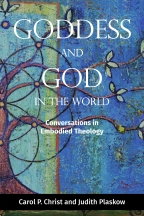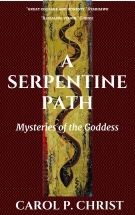 I have just received the following article from Carol Christ, author of many books of the Goddess and feminism as well as leader of a Goddess Pilgrimage to the island of Crete which I thought I would share as she touches on a number of rather interesting points, in particular the use of language and how it can be widely interpreted.
I have just received the following article from Carol Christ, author of many books of the Goddess and feminism as well as leader of a Goddess Pilgrimage to the island of Crete which I thought I would share as she touches on a number of rather interesting points, in particular the use of language and how it can be widely interpreted.
As Priestess in Residence of The Goddess House, I use the term "Divine Feminine" not in a similar context as Ms Christ's use of the term "sacred feminine" in her article (or at least not as we believe). To me, the "Divine Feminine" represents the Great Goddess in all her guises - from the care-free maid through to the wise (yet terrifying) Crone who is also the initiator and keeper of the ancient mysteries. Additionally, the use of the term "Divine Feminine" also represents the "energy" that is perceived with the concept of "feminine" - be it nurturing, love or even "warm and fuzzy" as well as "protective", "war-like", "frighting" etc. And I draw me use of the term from Goddesses depicted in mythology, very few of which are depicted as "delicate" as is often the common association to the word "feminine".
A further use of the concept "divine feminine" that can be found within the teachings shared by The Goddess House is the fact that as we are all created from the concept of the Divine (be it God, Goddess, Universal Energy or even self-creating star dust), we all therefore hold that potential of being "divine beings" ourselves - therefore, women as representatives of the "divine feminine" just as men are representatives of the "divine masculine". Our use of these phrases however are not as substitutes for "matrifocal” or “patriarchy” which we consider to holding completely separate meanings (at least in the context as raised by Ms Christ's article).

 Carol P. Christ is author or editor of eight books in Women and Religion and is one of the Foremothers of the Women’s Spirituality Movement. She also leads the Goddess Pilgrimage to Crete in Spring and Fall.
Carol P. Christ is author or editor of eight books in Women and Religion and is one of the Foremothers of the Women’s Spirituality Movement. She also leads the Goddess Pilgrimage to Crete in Spring and Fall.
With that explanation made, please find Ms Christ's thought provoking article about the concepts of "Sacred Feminine" and "Goddess Feminism".
The Sacred Feminine or Goddess Feminism
By Carol Christ
In recent years “the Sacred Feminine” has become interchangeable with (for some) and preferable to (for others) “Goddess” and “Goddess feminism”. The terms Goddess and feminism, it is sometimes argued, raise hackles: Is Goddess to replace God? And if so why? Does feminism imply an aggressive stance? And if so, against whom or what?
In contrast, the term “sacred feminine” (with or without caps) feels warm and fuzzy, implying love, care, and concern without invoking the G word or even the M(other) word–about which some people have mixed feelings. Advocates of the sacred feminine stand against no one, for men have their “sacred feminine” sides, while women have their “sacred masculine” sides as well.
Nothing lost, and much to be gained. Right? Wrong.
 |
| Perseus with the Head of Medusa |
When Goddess feminism emerged onto the scene early in the feminist movement, it had a political edge. It was about women affirming, as Meg Christian crooned in “Ode to a Gym Teacher”, that “being female means you still can be strong”. Goddess feminism arose in clear opposition to patriarchy and patriarchal religions. It was born of an explicit critique of societies organized around male domination, violence, and war; and of the male God or Gods of patriarchal religions as justifying domination, violence, and war. In this context, “the sacred masculine” was not understood to be a neutral or positive concept. To the contrary, the male Gods of patriarchy were understood to be at the centre of symbol systems that justify domination.
The terms “the masculine” and “the feminine” were floating around and sometimes evoked in early feminist discussions, but when examined more closely, they were rejected by most feminists as mired in sex role stereotypes. The psychologist Carl Jung, for example, associated the masculine with the ego and rationality and the feminine with the unconscious. True, he argued that modern western society had developed too far in the direction of the masculine and needed a fresh infusion of the feminine in order to achieve “wholeness.” This sounded good, but when feminists looked further, they discovered that Jung and his followers harboured a fear of the uncontrolled feminine.
Jungians consider the unconscious to be the repository of undisciplined desires, fears, and aggressive feelings that require the rational control of the ego. Though strong and intelligent women were among Jung’s most important followers, Jung and his male companions retained a fear of independent women, speaking of women who developed their rational sides fully enough to argue with men and male authorities as “animus-ridden”, a term not meant as a compliment.
 |
Hades Abducting Persephone:
Marriage of Sacred Masculine and
Sacred Feminine?
|
Jungians, following Erich Neumann, understand the progress of history through an evolutionary model in which humanity began in a matriarchal stage in which the unconscious reigned. This period of culture, which spawned the image of the Great and Terrible Mother, was primitive and irrational. Matriarchy was naturally superseded by patriarchy, in which the individual, the ego, and rationality emerged. In the patriarchal stage of culture, male Gods and heroes were the primary symbols, and rationality reigned supreme.
The patriarchal stage of culture had its limitations, which were revealed in the two World Wars of the twentieth century and the nuclear and environmental crises that followed. Rational man, Jungians argued, had come to the point where he needed to reconnect with his feminine side. The unconscious feminine was now understood to be a nurturing matrix that included the body, nature, and feeling, from which rational man should and could never fully separate himself.
The great archaeologist Marija Gimbutas also spoke of two cultures within Europe, an earlier matrifocal one she called Old Europe and a later patriarchal one. The Jungian Joseph Campbell endorsed Gimbutas’ work, leading some to assume that Gimbutas and Jungians hold similar theories of human history. In fact they do not: Gimbutas did not subscribe to an evolutionary theory of culture. She would never have said that the earlier matrifocal culture “had to be superseded” by the later patriarchal culture “in order for civilization to advance.” The clear conclusion to be drawn from Gimbutas’ work is that the patriarchal culture was in almost every way inferior to the one it replaced.
For Gimbutas, the agricultural societies of Neolithic Old Europe were peaceful, egalitarian, sedentary, highly artistic, matrifocal and probably matrilineal, worshiping the Goddess as the powers of birth, death, and regeneration. These societies did not evolve into a higher stage of culture, but were violently overthrown by Indo-European invaders. The culture the Indo-Europeans introduced into Europe was nomadic, patriarchal, patrilineal, warlike, horse-riding, not artistic, worshiping the shining Gods of the sun as reflected in their bronze weapons. Gimbutas did not look forward to a new “marriage” of matrifocal and patriarchal cultures. Rather she hoped for the re-emergence of the values of the earlier culture. Her theories had a critical edge: she did not approve of cultures organized around domination, violence, and war.
This critical edge is exactly what is lost when we begin to substitute the terms “sacred feminine” for “the Goddess” or “Goddess feminism” and “sacred masculine” for “patriarchy” and “patriarchal Gods”. When we allege that we all have our “masculine and feminine sides”, and that it is important “to reunite the masculine and the feminine”, it is easy to forget that in our history, the so-called sacred masculine has been associated with domination, violence, and war.
If we hope to create societies without domination, violence, and war, then we must transform the distorted images of masculinity and femininity that have been developed in patriarchy. We must insist that domination, violence, and war are no more part of masculinity or male nature than passivity and lack of consciousness are part of femininity or female nature. It may feel good to speak of reuniting the masculine and the feminine, but feeling good will not help us to transform cultures built on domination, violence, and war.

 Carol P. Christ is author or editor of eight books in Women and Religion and is one of the Foremothers of the Women’s Spirituality Movement. She also leads the Goddess Pilgrimage to Crete in Spring and Fall.
Carol P. Christ is author or editor of eight books in Women and Religion and is one of the Foremothers of the Women’s Spirituality Movement. She also leads the Goddess Pilgrimage to Crete in Spring and Fall.
A Serpentine Path: Mysteries of the Goddess will be published by Far Press in the spring of 2016. A journey from despair to the joy of life.
Goddess and God in the World: Conversations in Embodied Theology with Judith Plaskow will be published by Fortress Press in June 2016. Exploring the connections of theology and autobiography and alternatives to the transcendent, omnipotent male God.
Goddess and God in the World: Conversations in Embodied Theology with Judith Plaskow will be published by Fortress Press in June 2016. Exploring the connections of theology and autobiography and alternatives to the transcendent, omnipotent male God.


As usual, I agree with Carol Christ. You may also be interested in my 2008 blog post, "Female? Feminine?"
ReplyDeletehttp://medusacoils.blogspot.com/2008/06/female-feminine.html, which I elaborate on in my book, _Goddess Mattters_ (Chapter 12: "Why Not 'Feminine Divine').